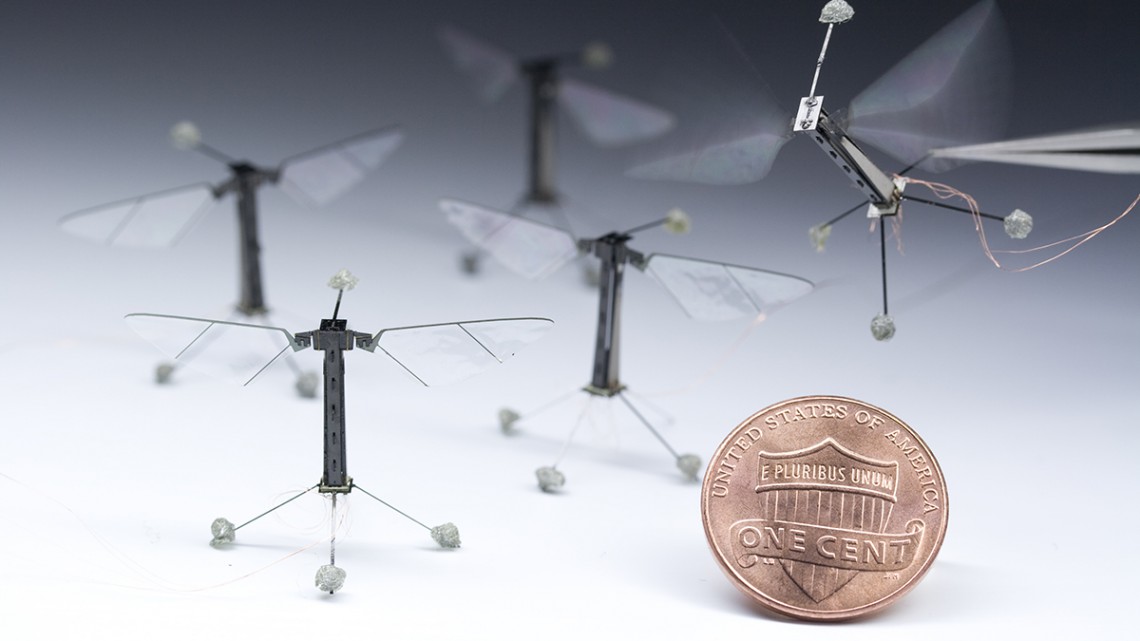
Brief News of Cognitive Navigation (2017-002)
1. This Autonomous Quadrotor Swarm Doesn’t Need GPS
By Evan Ackerman Posted 27 Dec 2017

- Researchers are working hard towards independent autonomy for flying robots,
- The University of Pennsylvania has been doing some particularly amazing development in this area, and they’ve managed to teach a swarm of of a dozen 250g quadrotors to fly in close formation, even though each one is using just one small camera and a simple IMU.
- This is probably the largest swarm of quadrotors which don’t rely on motion capture or GPS.
- All the autonomy components are working onboard
More info on IEEE Spectrum
2. Engineers program tiny robots to move, think like insects
By Syl Kacapyr December 13, 2017

- While engineers have had success building tiny, insect-like robots, programming them to behave autonomously like real insects continues to present technical challenges.
- A group of Cornell engineers has been experimenting with a new type of programming that mimics the way an insect’s brain works, which could soon have people wondering if that fly on the wall is actually a fly.
- Unlike traditional chips that process combinations of 0s and 1s as binary code, neuromorphic chips process spikes of electrical current that fire in complex combinations, similar to how neurons fire inside a brain.
- Ferrari’s lab is developing a new class of “event-based” sensing and control algorithms that mimic neural activity and can be implemented on neuromorphic chips.
- Ferrari’s lab has teamed up with the Harvard Microrobotics Laboratory, which has developed an 80-milligram flying RoboBee outfitted with a number of vision, optical flow and motion sensors.
- “You can’t really rely on prior modeling of the robot to do this, so we want to develop learning controllers that can adapt to any situation.” said Ferrari.
More info on Cornell.edu
3.The future of flying cars: science fact or science fiction?
By Jonathan Roberts and Michael Milford May 8, 2017

- Uber has shaken up the taxi industry and is trying to put driverless cars on our roads. Now the company aims to have flying ride-sharing vehiclesin our skies by 2020.
- Uber is not alone in working towards flying cars. But is this realistic, or just marketing hype?
- To many of us, the concept of flying cars is synonymous with the future, just like silver jumpsuitsand gourmet food in the form of a pill. Those dreams have not yet materialised so what about flying cars?
- How safe?
- How fast, how far?
- How easy?
- How much?
- How long the before I can fly to work?
More info on The Conversation
About
Brain Inspired Navigation Blog
New discovery worth spreading on brain-inspired navigation in neurorobotics and neuroscience
Recent Posts
- How human, animals, robots encode and recall place?
- How the brain constructs time and space and how these are related to episodic memory?
- How environmental novelty modulate rapid cortical plasticity during navigation?
- How the Hippocampal Cognitive Map Supports Flexible Navigation?
- How the geometric structure and underlying circuit organization of hippocampal population dynamics facilitate both memory discrimination and generalization, enabling efficient and flexible learning?
Tags
3D Grid Cells
3D Head-Direction Cells
3D Navigation
3D Place Cells
3D Spatial Representation
Allocentric
brain
Brain-inspired Navigation
Brain Navigation
CA1
CAN
Cognitive Map
Cognitive Navigation
Continuous Attractor Neural Network
Direction
Egocentric
Episodic Memory
Goal-Directed Navigation
Grid Cell
Grid Cells
head-direction cells
Head Direction
Head Direction Cell
hippocampal
Hippocampus
Indoor Navigation
Insect Navigation
Learning
Medial Entorhinal Cortex
Memory
Navigation
Neural Dynamics
Path Integration
Place Cell
Place Cells
RatSLAM
Representation
Self-Motion
SLAM
Spatial Cognition
spatial memory
Spatial Navigation
Spatial Representation
time
Time Cells
Categories
- 3D Movement
- 3D Navigation
- 3D Path Integration
- 3D Perception
- 3D SLAM
- 3D Spatial Representation
- AI Navigation
- Bio-Inspired Robotics
- Brain Inspired Localization
- Brain-Inspired Navigation
- Cognitive Map
- Cognitive Navigation
- Episodic Memory
- Excerpt Notes
- Flying Vehicle Navigation
- Goal Representation
- Insect Navigation
- Learning to Navigate
- Memory
- Neural Basis of Navigation
- Path Integration
- Path Planning
- Project
- Research Tips
- Robotic Vision
- Self-Flying Vehicles
- Semantic Memory
- Spatial Cognition
- Spatial Cognitive Computing
- Spatial Coordinate System
- Spatial Learning
- Spatial Memory
- Spatial Resoning
- Time
- Unclassified
- Visual Cortex
- Visual Cue Cells
Links
- Laboratory of Nachum Ulanovsky
- Jeffery Lab
- BatLab
- The NeuroBat Lab
- Taube Lab
- Laurens Group
- Romani Lab
- Moser Group
- O’Keefe Group
- DoellerLab
- MilfordRobotics Group
- The Space and Memory group
- Angelaki Lab
- Spatial Cognition Lab
- McNaughton Lab
- Conradt Group
- The Fiete Lab
- The Cacucci Lab
- The Burak Lab
- Knierim Lab
- Clark Spatial Navigation & Memory Lab
- Computational Memory Lab
- The Dombeck Lab
- Zugaro Lab
- Insect Robotics Group
- The Nagel Lab
- Basu Lab
- Spatial Perception and Memory lab
- The Neuroecology lab
- The Nagel Lab
- Neural Modeling and Interface Lab
- Memory and Navigation Circuits Group
- Neural Circuits and Memory Lab
- The lab of Arseny Finkelstein
- The Epstein Lab
- The Theoretical Neuroscience Lab
- Gu Lab (Spatial Navigation and Memory)
- Fisher Lab (Neural Circuits for Navigation)
- The Alexander Lab (Spatial Cognition and Memory)
- Harvey Lab (Neural Circuits for Navigation)
- Buzsáki Lab
- Brain Computation & Behavior Lab
- ……